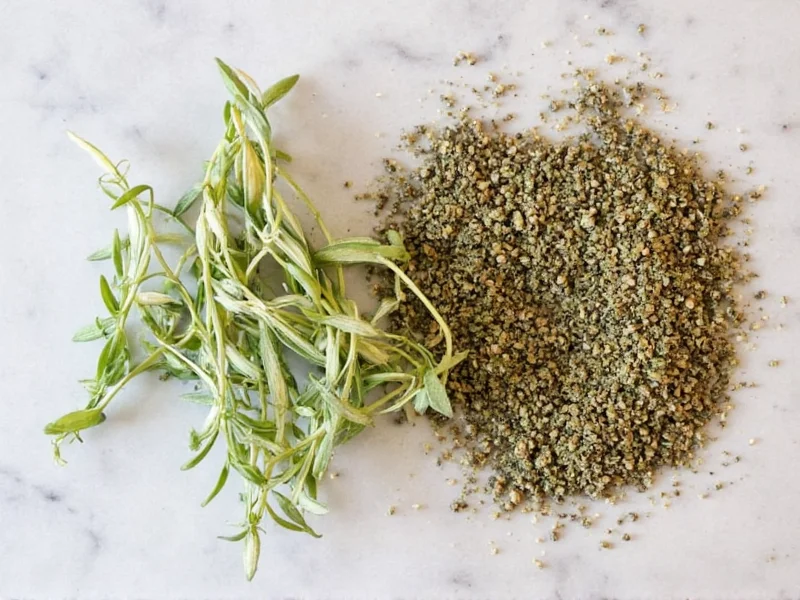Why Fresh and Dried Oregano Require Conversion
Oregano undergoes significant chemical changes during the drying process. Fresh oregano leaves contain high moisture levels (approximately 85%), which dilutes their flavor compounds. When dried properly, oregano loses this water content, concentrating its essential oils and flavor compounds. This concentration is why you need less dried oregano than fresh in recipes.
The 3:1 ratio isn't arbitrary—it's based on flavor concentration measurements from culinary research. Dried oregano typically contains three times the flavor compounds per volume compared to fresh. This scientific basis makes the conversion reliable across most cooking applications.
Fresh to Dry Oregano Conversion Chart
| Fresh Oregano | Dried Oregano Equivalent |
|---|---|
| 1 teaspoon | ⅓ teaspoon |
| 1 tablespoon | 1 teaspoon |
| ¼ cup | 1¼ tablespoons |
| ½ cup | 2½ tablespoons |
| 1 cup | ⅓ cup |
Practical Tips for Oregano Substitution
When converting fresh to dry oregano in recipes, consider these professional cooking insights:
- Add dried oregano earlier: Dried herbs need time to rehydrate and release flavors. Add them during the cooking process rather than at the end.
- Crush dried oregano: Rub dried oregano between your fingers before adding to release essential oils and maximize flavor.
- Adjust for freshness: Older dried oregano loses potency. If your dried oregano is more than 6 months old, increase the amount by 25%.
- Consider the dish type: For tomato-based sauces, you can sometimes use a 2.5:1 ratio as acidity enhances dried herb flavors.
Understanding Flavor Differences Beyond Measurement
While the 3:1 fresh to dry oregano conversion ratio provides accurate measurement substitution, the flavor profiles differ slightly. Fresh oregano offers brighter, grassier notes with subtle citrus undertones, while dried oregano develops deeper, more earthy characteristics with intensified bitterness.
For Mediterranean dishes like Greek salads or Italian tomato sauces, these flavor differences matter. When substituting, consider adding a pinch of lemon zest with dried oregano to mimic fresh oregano's brightness. This professional chef technique bridges the flavor gap while maintaining proper measurement conversion.
Storage Recommendations for Maximum Potency
Proper storage significantly impacts dried oregano's effectiveness in fresh to dry oregano conversion. Store dried oregano in an airtight container away from light and heat. Under optimal conditions, dried oregano maintains peak potency for 6-12 months.
Test your dried oregano's freshness by rubbing a small amount between your fingers. If the aroma is weak or musty, it's lost significant flavor compounds, and you'll need to increase the amount beyond standard fresh to dry oregano conversion ratios. Fresh oregano stored in the refrigerator with stems in water lasts 7-10 days before flavor degradation begins.
Common Conversion Mistakes to Avoid
Many home cooks make critical errors when converting fresh oregano to dried. The most frequent mistake is using equal measurements, resulting in overpowering dishes. Another common error involves not accounting for oregano variety—Greek oregano is more potent than Italian varieties, requiring slight ratio adjustments.
When following recipes that don't specify oregano type, assume standard culinary oregano (Origanum vulgare). For wild oregano varieties, reduce the dried amount by 20% from standard conversion ratios. Always remember that fresh oregano measurement to dried conversion works in one direction only—converting dried to fresh requires tripling the amount, not halving it.
Frequently Asked Questions
Can I use dried oregano instead of fresh in pizza sauce?
Yes, use 1 teaspoon of dried oregano for every tablespoon of fresh oregano called for in pizza sauce recipes. Add the dried oregano during the simmering process to allow proper rehydration and flavor development.
Why does the fresh to dry oregano conversion ratio matter in cooking?
The ratio matters because dried oregano has three times the concentrated flavor of fresh due to moisture removal. Using equal amounts would make dishes overly potent, while using too little would result in under-seasoned food. Proper fresh oregano to dried oregano conversion ensures balanced flavor.
How do I convert dried oregano back to fresh measurements?
To convert dried oregano to fresh, multiply the dried amount by three. For example, 1 teaspoon of dried oregano equals 1 tablespoon of fresh oregano. This reverse conversion for oregano substitution works because dried herbs are more concentrated.
Does the fresh to dry oregano conversion ratio change for different cooking methods?
Yes, the ratio can vary slightly. For slow-cooked dishes, use a 2.5:1 ratio as prolonged cooking extracts more flavor from dried oregano. For quick-cooking applications like salad dressings, maintain the standard 3:1 fresh to dry oregano conversion ratio since there's less time for flavor development.
Can I substitute dried oregano for fresh in Greek salad?
While possible, dried oregano doesn't work well in raw applications like Greek salad. Fresh oregano provides the bright, grassy notes essential to the dish. If you must substitute, use ⅓ the amount of dried oregano and mix it with lemon juice first to help rehydrate and mellow the flavor for fresh oregano measurement to dried conversion in raw dishes.











 浙公网安备
33010002000092号
浙公网安备
33010002000092号 浙B2-20120091-4
浙B2-20120091-4